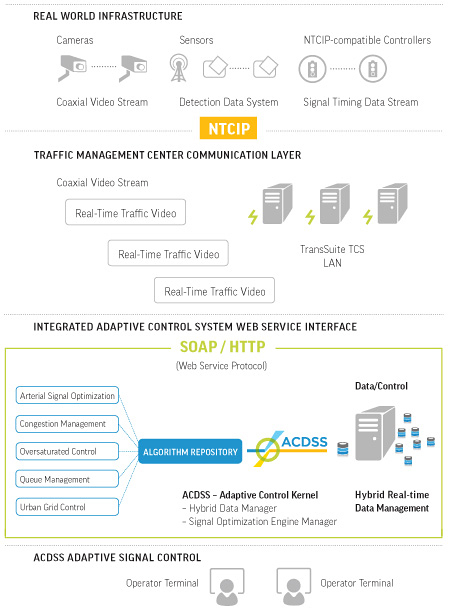The Adaptive Control Decision Support System
INTELLIGENT CONTROL
FOR SMARTER SIGNALS

|

|
||
 |
|
||
|
ARTERIAL APPLICATIONS ACDSS optimizes arterial signals by adjusting cycle, offsets and splits asynchronously. The system assesses traffic conditions as frequently as multiple times within a cycle, to decide the best signal timing parameters at the next “local zero”. This enables a faster-than-a-cycle responsiveness without the need for second-by-second data and control. If a change of offsets or cycle length is found beneficial, the new parameters are implemented at the next local zero. This is followed by a pattern-hold period, where only splits are continuously adjusted. URBAN ADAPTIVE CONTROL & CONGESTION MANAGEMENT To preserve capacity and improve mobility in congested urban networks, ACDSS combines real-time demand regulating signal plans with dynamic queue management at critical intersections. Signal timing plans are selected in real-time according to the prevalent congestion levels to better utilize storage space and redistribute traffic. This works in concert with balancing queue storage ratios at critical intersections to systematically alleviate urban congestion. OPTIMIZATION ALGORITHM REPOSITORY ACDSS features a unique design of Signal Optimization Algorithm Repository. Several algorithms, from delay minimization, diamond interchange control, to queue management, are incorporated as switchable plug-ins in the system’s algorithm repository. This Signal Optimization Algorithm Repository concept enables regional variable-objective, multi-regime adaptive control not available from other systems. It also provides the flexibility to incorporate any state-of-the-art algorithms developed from existing and future emerging ITS technologies as needed, when needed. |
 |
||
 |
JUST-IN-TIME (JIT) SIMULATION ACDSS supports integrated real-time simulation for on-line performance evaluation. It provides flexible interfaces to existing commercial traffic simulators such as Aimsun or VISSIM. With JIT simulation, a operator can launch multiple instances of traffic simulation ”just in time” to compare scenarios and choose the best available signal timing alternatives. |
||
|
SYSTEM REQUIREMENTS ACDSS is designed to work with most NTCIP-compatible controllers. At a minimum, it requires volume and occupancy from selected mid-block locations, and supports sparse detectorization with minimal number of detectors. The volume and occupancy data should be aggregated approximately every 30 seconds. In addition, ACDSS uses travel time data where available for urban adaptive control and congestion management. ACDSS uses a web service interface to the traffic management system which is responsible for retrieving data from the field sensors and downloading updated timing pattern information. The web service interface uses SOAP; ACDSS polls controller status and detection data through the web service as frequently as every 5 seconds. ACDSS maintains a hybrid database management structure. Short-term data is cached in memory for computational efficiency. In addition, all data is permanently archived including detector data, controller status, and operation logs. This data is used for online data fusion in the case of sparse detectorzation and offline analysis and reporting. PRIMED FOR THE FUTURE ACDSS has been designed to use existing controllers and detection equipment, with minimum investment in additional infrastructure, training, and maintenance. The system in itself is very flexible and extensible allowing the incorporation of future ITS technologies and emerging R&D optimization programs, thanks to its cutting-edge design and implementation.
|
OPERATION ACDSS supports both autonomous operation (without operator interactions) and operator-in-the loop validation. When it comes to tactical control decisions such as shifting strategies from achieving smooth flow to congestion management, the operator can approve or reject system-recommended plans or strategies. ACDSS in fully autonomous mode runs as system service and supports 7/24 operations. The adaptive control system can also be activated based on time of day, day of week or date of month schedules. Time-of-day plans are employed as the default fall-back plans in case of communication failure or system exceptions. |
|


